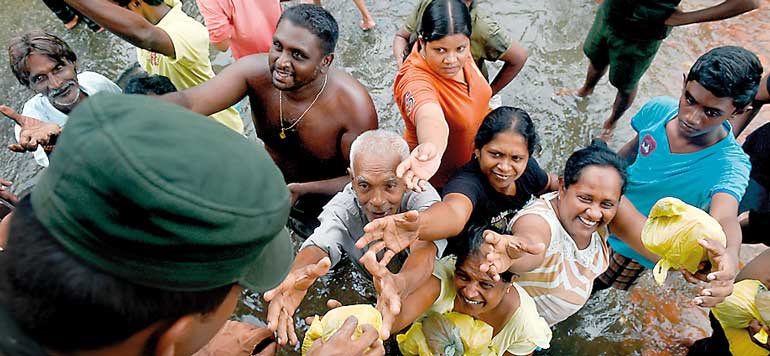Tuesday Apr 23, 2024
Tuesday Apr 23, 2024
Thursday, 26 May 2016 00:00 - - {{hitsCtrl.values.hits}}

A young Sri Lankan flood victim sits at a roadside temporary shelter at the Kelaniya bridge, on the outskirts of Colombo on 22 May. Sri Lankan soldiers have pulled more bodies from landslides and distributed food and water to hundreds of thousands forced into shelters after major floods hit the island. Floodwaters were receding in the capital Colombo after the heaviest rains in 25 years pounded the island since last weekend, triggering landslides that have buried victims in tons of mud – AFP

A Sri Lankan resident puts school books out to dry as floodwaters recede in the Biyagama suburb of the capital Colombo on 23 May. Sri Lankan soldiers distributed food and water to hundreds of thousands forced into shelters after major floods hit the island – LakruwanWanniarachchi/AFP

The Sri Lankan army distributes food to flood victims in Kelaniya, on the outskirts of Colombo on 22 May. Sri Lankan soldiers pulled more bodies from landslides and distributed food and water to hundreds of thousands of residents camped in shelters on 22 May after major floods hit the island. More than 80 people are known to have died so far across the island amid fears the number could rise, with118 people still listed as missing – AFP
AFP: Sri Lankans camped out in shelters in the capital face an uncertain future after massive flooding from torrential rain struck the island, forcing them to flee their inundated homes.
Water levels in Colombo are slowly falling after the Kelani River running through the city of 650,000 burst its banks early last week, and a cleanup is underway.
But many of the 100,000-odd residents still sheltering in schools and other relief centres in Colombo say they have lost everything and are unsure how to rebuild.
“We have no shortage of food, but the issue is how do we go back home?” said single mother Dinesha Devi, who has spent five days camped in a classroom at the Vidyawardena school on the city’s outskirts.
“We have lost everything we had. I don’t even have any change of clothes for Nilakshan let alone for myself,” Devi said of her 21-month-old toddler.
Devi was one of thousands who clambered onto rubber dinghies and makeshift rafts after the rains hit, triggering huge landslides northeast of the capital that buried two villages.
More than 90 people are so far known to have died across the island, although that number could rise with more reported missing, the national Disaster Management Centre said.
The Government called a special session of Parliament for Wednesday to discuss how best to respond to the floods, which the Finance Ministry estimates has caused $2 billion worth of damage.
The Government has promised compensation to those affected in 22 of Sri Lanka’s 25 districts, but no details have yet been announced. Most people outside Colombo have already returned home.
Joyce Patricia told AFP waters raced through the small shop that she owns with her family and they have no money to restart the business.
FareenaShahul, a travelling saleswoman, voiced similar concerns, saying her entire stock of clothing had been destroyed.
“I used to sell clothes, but today I am left with what I am wearing and I have to ask for clothes from others,” the 45-year-old said as she also sheltered at the VidyawardenaSchool in a poor Colombo suburb.
Housewife SanujaRatnayake, 37, said she had tried to return home but found it filled with about two feet of stinking black sludge.
“We will not be able to do the cleanup ourselves,” she said at the school. “We will need a lot of help.”